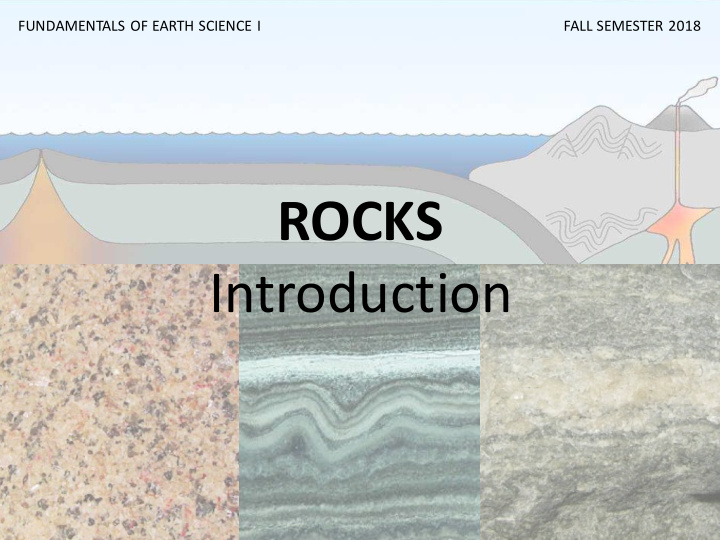



FUNDAMENTALS OF EARTH SCIENCE I FALL SEMESTER 2018 ROCKS Introduction
What is a rock? A Rock is 1. a natural substance 2. solid 3. an aggregate of mineral matter (see exceptions below) Mineral Non-mineral Non-mineral www.beg.utexas.edu www.geology.com Granite Obsidian (volcanic glass) Coal
Why study rocks? 1. To understand the origin and evolution of the Earth and other objects of our solar system (and validate models predicting the future of Earth’s global environment and sea level change) 2. To find and extract economically importance resources (oil, coal, mineral ores) on Earth, and perhaps soon elsewhere too! 3. To solve environmental problems (storage of radioactive substances, CO 2 , and diffusion of pollutants) 4. To find and extract groundwater
Properties of rocks 1. Color 2. Texture 1. Size (coarse vs. fine) of crystals 2. Shape or grains 3. arrangement 3. Composition 1. Nature of constituents (mineral crystals, fossils, rock fragments) 2. Mineralogical composition (nature of minerals) 3. Chemical composition (relative abundance of chemical compounds like H 2 O or elements like Fe, Ti…) 4. Physical properties (magnetic, electrical, mechanical, thermal…)
The three families of rocks 1. Igneous rocks • Solidification of molten rock (magma/lava) Examples : basalt, granite 2. Sedimentary rocks • Accumulation of sediments (grains or minerals) Examples : sandstone, reef limestone, evaporite 3. Metamorphic rocks • Transformation of preexisting solid rock under high pressure / temperature or in contact with hot – hydrothermal – fluids Examples : gneiss, schist, marble
Distribution of rocks controlled by plates tectonics INGNEOUS ROCKS METAMORPHIC ROCKS SEDIMENTARY ROCKS Crystallisation of magma Transformation of rocks in a Accumulation of sediments Slow cooling Rapid cooling solid state by P, T, hot fluids Siliciclastic sediments Earth’s surface Earth’s interior Regional metamorphism Chemical sediments Extrusive rocks Intrusive rocks Contact metamorphism… Biological sediments Coarse -grained Fine -grained Conv. Boundaries e.g. Granite e.g. Basalt Ocean basins Mountains Plate boundaries Hot spots
The rock cycle SOLIDIFICATION Controlled by plate tectonics and climate
Link between plate tectonics, CO 2 climate and the rock cycle Global volcanism Influence climate over 10 6 years Climate Ocean sediments and influences the Continental sedimentary rocks production of lithosphere sediments Ocean Mid-Ocean Ridge lithosphere Erosion Ocean Basin Sediments Magma Magma Asthenosphere High P/T Plate tectonics controls the formation Hot mantle of ocean basins and mountain chains rock rising NB: Silicate weathering also influences the atmospheric concentration of CO 2 over 10 6 years (see chapter on sedimentary rocks)
Recommend
More recommend